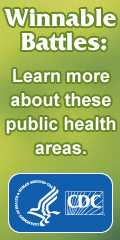May 2015
Did You Know? is a weekly feature from the Office for State, Tribal, Local and Territorial Support to inform your prevention activities. We invite you to read, share, and take action!
View the Current Did You Know?
May 29, 2015
- CDC has a new tool to help public health agencies, organizations, and individuals improve and invest [PDF–503KB] in the health of their communities: the Community Health Improvement Navigator.
- Search the Navigator and its database for interventions that work and case examples that public health agencies can use to partner with hospitals.
- By working together, engaging the community, communicating, and sustaining results, you can help make your community health improvement efforts collaborative and successful.
May 22, 2015
- Thalassemia major is a rare but serious disease that causes people to produce fewer red blood cells than usual (anemia).
- People with severe thalassemia require ongoing treatment to reduce complications such as enlarged spleen, bone disease, infections, and too much iron in the body.
- By seeking care at a thalassemia treatment center and carefully following a treatment plan, people with thalassemia can live a healthy life.
May 15, 2015
- You can get norovirus—a very contagious stomach bug—by swimming in water contaminated with poop or vomit.
- Recreational water illnesses, like those caused by norovirus, spread when an infected swimmer poops or vomits in the water and other swimmers swallow it.
- You can protect others from recreational water illnesses by getting the word out and sharing helpful CDC materials, including infographics, fact sheets, and posters.
May 8, 2015
- According to this month’s Vital Signs, on average, 1 in 3 Hispanics in the US don’t speak English well, which limits their ability to understand health information in English.
- Hispanics are 50% more likely to die from diabetes or liver disease than non-Hispanic whites.
- Health professionals can collaborate with promotores (community health workers) to help Hispanics get appropriate educational materials in Spanish and to learn about their specific risk factors.
May 1, 2015
- Use of e-cigarettes and hookahs skyrocketed among middle and high school students between 2013 and 2014, offsetting declines in use of other tobacco products.
- About 4.6 million middle and high school students currently use tobacco products. Youth use of tobacco in any form--combustible, noncombustible, or electronic--is unsafe.
- Apps, text messages, and other tools, as well as resources from state tobacco control programs, can help keep teens from using tobacco.
Did You Know? information and web links are current as of their publication date. They may become outdated over time.
- Page last reviewed: November 9, 2015
- Page last updated: October 14, 2016
- Content source:



 ShareCompartir
ShareCompartir



